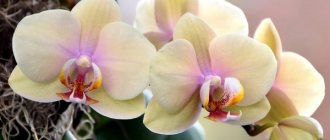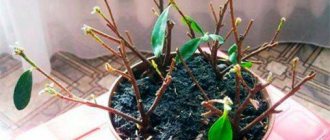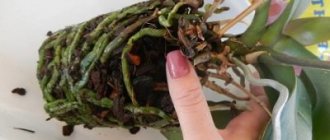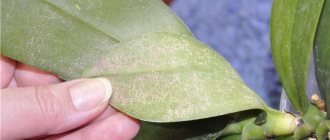When and how often?
In favorable conditions, phalaenopsis produce 2 waves of flowering, the duration of each of them is up to 3 months. Upon completion of the first wave, the plant has a short break (no more than 2 months), after which flowering begins again. In the presence of artificial lighting, orchids bloom regardless of the time of year. Without additional lighting, the process is cyclical:
- spring – the beginning of the first phase;
- mid-summer - the formation of new buds after the end of the first phase, the appearance of lateral buds on old peduncles;
- the last days of summer and the beginning of autumn - the second phase of flowering;
- winter period - break.
How does the peduncle appear?
An orchid peduncle is a shoot that differs from the root shoot by its pointed end and scaly covering. The peduncle appears from the leaf axil and grows in any direction, curving bizarrely.
From a growing point and a waiting bud
Sometimes there are deviations in the growth of the peduncle and it can develop from a growing point, and during repeated flowering, from a waiting bud located on the previous flower shoot. In this case, there is no need to panic, just be more attentive to the changed conditions. During this period, the orchid is most sensitive to various stresses.
If the peduncle appears from the growing point, then usually after flowering the plant will produce a baby, which will already bloom in the usual way, releasing an arrow from the leaf axil.
If a new peduncle appears on the peduncle, it means that the old flower arrow has not yet dried out and continues to live. This phenomenon occurs when the orchid finishes flowering in the spring. When a new peduncle appears, a small number of buds are formed on the old one, and its growth is observed to the side of the main stem.
In this case, the plant needs to be given more light, increased humidity and fed with special fertilizers for orchids. If the phalaenopsis looks weakened, then the peduncle should be cut off after the first flowering.
Photo
The photo shows options for the appearance of the peduncle:
From the leaf axil
From the point of growth
From a waiting bud
What to do with an orchid that won't bloom again
If the tip of the peduncle has dried out and changed its color, turned yellow or blackened, it is hardly worth waiting for new buds. In this case, it is better to cut the peduncle - to the very base or slightly above the highest “dormant” point. Most varieties of orchids have several “sleeping” buds - they are covered with protective scales. As the plant develops further, these buds may begin to grow. This will form a side peduncle or “baby”.
You can try to get re-blooming on the old stem. To do this, you need to cut it a couple of centimeters above the bud. But there are no guarantees that the buds will definitely wake up - the plant can simply stand for a while and then dry out from old age.
Favorable conditions
In order for an orchid to bloom regularly at home, it needs to create favorable conditions.
Temperature
After the appearance of the peduncle, phalaenopsis needs to ensure a difference in day and night temperatures, the approximate difference between them is 5–6 °C. The indicator should not exceed +25 °C during the day, and +18 °C at night.
During the flowering period, which occurs in the summer, it is recommended to install the orchid on a windowsill or take it out onto the balcony, thereby eliminating the occurrence of drafts.
Humidity
The optimal humidity level in a room with flowering phalaenopsis is at least 60%. To ensure this indicator, place a container of water near the pot or carefully spray the leaves from a spray bottle.
Lighting
A prerequisite for full flowering of an orchid is a long daylight hours (12 hours). This is especially true during the cold season or cloudy days. In this case, additional lighting is provided for the upper part of the peduncle. If there is a lack of lighting, the flowering of the plant stops.
Watering
The recommended frequency of watering after the orchid has formed buds is 2 times a week, on too hot days with low humidity - 3 times. In this case, the liquid is poured in small portions to prevent stagnation of moisture in the soil.
Read about all the ways to water a phalaenopsis orchid in this article.
Required Capacity
Since the roots of phalaenopsis take part in photosynthesis, they need light, which means the plant should choose a transparent pot. D but must be equipped with holes for drainage with a diameter of 3–7 mm.
The height of the container for orchids corresponds to the diameter of the neck, and the width is 3 cm greater than the volume of the root system. Read how to choose a suitable pot for phalaenopsis here.
Priming
Basic requirements for the soil mixture:
- environmentally friendly, no toxins;
- sufficient water and air permeability;
- ease;
- optimal acidity level;
- content of useful elements and minerals.
In stores, soil suitable for epiphytes is called “Mixture for Phalaenopsis.”
Read how to choose a substrate for phalaenopsis in the store and make it yourself here.
Fertilizer and feeding
Fertilizers are applied taking into account the flowering phase of phalaenopsis. During the formation of peduncles and buds, the main elements in feeding are phosphorus and potassium. During the period of active flowering, the dosage is reduced by 3 times or fertilizers are completely abandoned. In the final stage (during wilting), balanced preparations are recommended; they are applied within 2 weeks after the last flowers have dried.
Growing young phalaenopsis
After the young shoot is separated from the adult phalaenopsis, it can be rooted. The procedure must be carried out with extreme caution so as not to damage the delicate plant. For this you will need:
- Young shoot of phalaenopsis.
- Transparent plastic flower pot. It is better to choose a small one. The diameter of its bottom should not exceed 10 cm.
- Special soil for planting orchids, consisting of bark and moss. There should be more bark in it than moss.
- Crushed activated carbon or cinnamon powder. They should definitely sprinkle the cut of the shoot.
It is necessary to make several holes in the pot to allow excess liquid to escape (holes are needed not only in the bottom, but also on the walls of the pot). Then fill it with substrate, root the shoot, add a little more bark to the level of the orchid’s neck, and water the plant.
During the first time of a new flower’s life, you need to monitor the condition of its roots by carefully lifting the upper pieces of the bark. If signs of disease appear on the roots, you can try to revive them with succinic acid.
How to renew a house?
It is possible to increase the flowering time of phalaenopsis by providing it with the following conditions:
- sufficient lighting;
- the difference between daytime and nighttime temperatures is +5 °C;
- timely application of special fertilizers for orchids containing phosphorus and potassium, use of fertilizers every fourth watering;
- avoiding overmoistening of the growing point.
To stimulate re-blooming, experts recommend cutting off the peduncle above the fourth knee, and then periodically spraying it with warm water.
It should be remembered that repeated flowering depletes the orchid.
Care after flowering: what to do next?
After the phalaenopsis has bloomed, it is examined:
- if there are signs of drying of the peduncle, cut it off;
- in case of overgrown roots, replant.
During the dormant period, it is important to follow all the rules of agricultural technology, otherwise you may not wait for re-flowering. The flower pot is placed in a warm and bright place and at the same time protected from direct sunlight.
Possible problems
After phalaenopsis blooms, a number of problems may appear:
- delay of subsequent flowering;
- wilting of leaves;
- drying out of the entire plant.
All of them are a consequence:
- location too bright;
- frequent, abundant fertilizing;
- trimming the flower stalk before it dries out;
- the arrow is removed too short (less than 1.5 cm).
Orchid is very demanding to care for. Therefore, it is worth paying special attention to it. As soon as signs of a particular problem are detected, it is immediately solved.
Should I cut the arrow or not?
Before taking any action regarding the peduncle, evaluate its condition:
- the brown and dried ones are cut off, leaving a small stump at the base;
- a slowly drying peduncle, on which there are swollen buds, is cut 2–3 cm to the green part or the upper bud, in which case re-blooming will occur on the same shoot.
If the arrow does not dry out immediately, but swelling of the buds is not observed on it, there is no need to rush with pruning, since the orchid at this time is still receiving nutrients from the peduncle.
Stimulate the growth of new
With this option, it is necessary to trim the peduncle to the “stump”. It’s simple: we remove the old ones, expect new ones to appear, following the recommendations “how to help an orchid bloom.”
For pruning, prepare a tool with a sharp blade. Disinfect it and sprinkle the cut area with crushed charcoal. This way you will protect your plant from various diseases. However, not everyone adheres to this recommendation.
Related article:
Propagating an orchid
Why don't buds form?
The lack of flowering of phalaenopsis may be due to a number of factors:
- negative impact of external factors: inappropriate temperature, lighting, etc.;
- improper feeding and watering;
- damage to the plant by any disease or pest.
In some cases, the orchid does not bloom, despite favorable conditions. This problem is solved within 14 days in one of the following ways:
- reducing the frequency of watering;
- gradual decrease in room temperature to +16 °C.
After the first buds appear and bloom, the rules of agricultural technology change slightly; this technique allows you to prolong the flowering process. Read more about how to make a phalaenopsis orchid bloom here.











